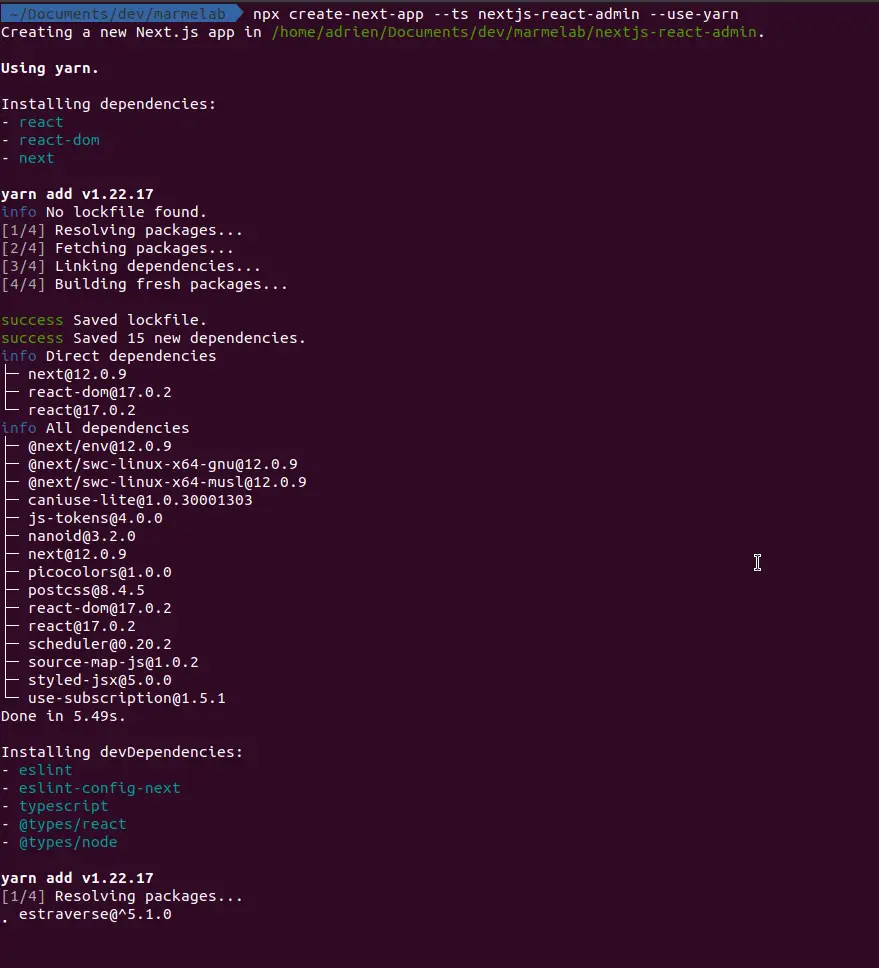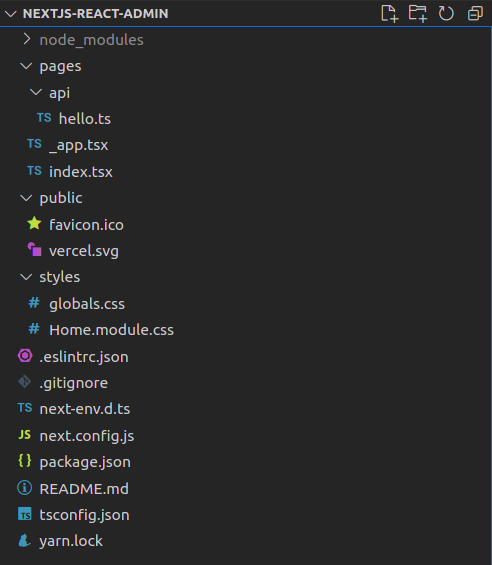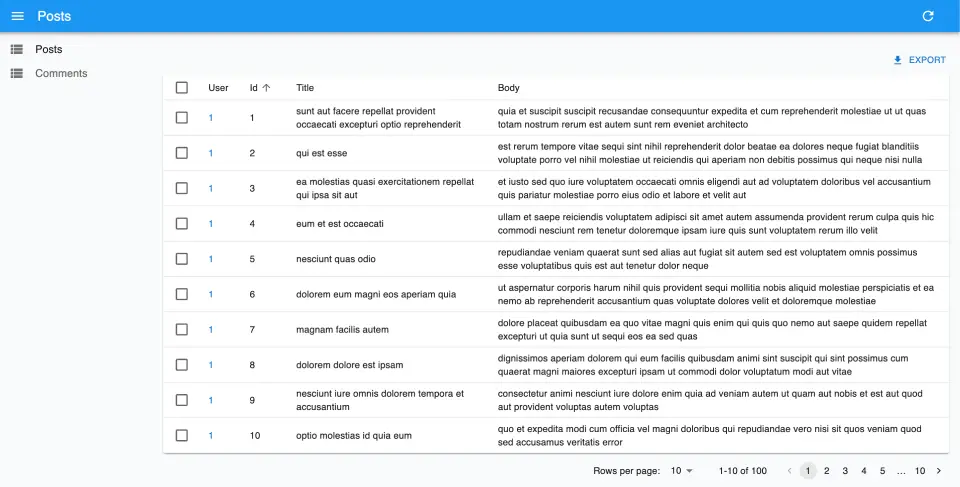Next.js Integration
React-admin runs seamlessly on Next.js, with minimal configuration.
Setting Up Next.js
Let’s start by creating a new Next.js project called nextjs-react-admin.
npx create-next-app --ts nextjs-react-admin --use-yarn

This creates a project with the following folder structure:

Setting Up React-Admin
Add the react-admin npm package, as well as a data provider package. In this example, we’ll use ra-data-json-server to connect to a test API provided by JSONPlaceholder.
yarn add react-admin ra-data-json-server
Next, create the admin app component in src/admin/App.jsx:
// in src/admin/App.jsx
import * as React from "react";
import { Admin, Resource, ListGuesser } from 'react-admin';
import jsonServerProvider from 'ra-data-json-server';
const dataProvider = jsonServerProvider('https://jsonplaceholder.typicode.com');
const App = () => (
<Admin dataProvider={dataProvider}>
<Resource name="posts" list={ListGuesser} />
<Resource name="comments" list={ListGuesser} />
</Admin>
);
export default App;
This is a minimal admin for 2 resources. React-admin should be able to render a list of posts and a list of comments, guessing the data structure from the API response.
Using React-Admin As The Root Application
Now, let’s configure Next.js to render the admin app component in the root path (‘/’). Edit the file called pages/index.tsx, and replace the content with the following:
// in pages/index.tsx
import type { NextPage } from "next";
import dynamic from "next/dynamic";
const App = dynamic(() => import("../src/admin/App"), { ssr: false });
const Home: NextPage = () => {
return <App />;
};
export default Home;
Tip: Why the dynamic import? React-admin is designed as a Single-Page Application, rendered on the client-side. It comes with its own routing sytem, which conflicts with the Next.js routing system. So we must prevent Next.js from rendering the react-admin component on the server-side. Using dynamic allows disabling Server-Side Rendering for the <App> component.
Now, start the server with yarn dev, browse to http://localhost:3000/, and you should see the working admin:

Rendering React-Admin In A Sub Route
In many cases, the admin is only a part of the application. For instance, you may want to render the admin in a subpath, e.g. /admin.
Next.js makes it trivial: create a pages/admin.tsx file with the same content as in the previous section:
// in pages/admin.tsx
import type { NextPage } from "next";
import dynamic from "next/dynamic";
const App = dynamic(() => import("../src/admin/App"), { ssr: false });
const Admin: NextPage = () => {
return <App />;
};
export default Admin;
Now the admin renders at http://localhost:3000/admin, and you can use the Next.js routing system to add more pages.
Adding an API
Next.js allows to serve an API from the same server. You could use this to build a CRUD API by hand. However, we consider that building a CRUD API on top of a relational database is a solved problem and that developers shouldn’t spend time reimplementing it.
For instance, if you store your data in a PostgreSQL database, you can use PostgREST to expose the data as a REST API with zero configuration. Even better, you can use a Software-as-a-Service like Supabase to do that for you.
In such cases, the Next.js API can only serve as a Proxy to authenticate client queries and pass them down to Supabase.
Let’s see an example in practice.
First, create a Supabase REST API and its associated PostgreSQL database directly on the Supabase website (it’s free for tests and low usage). Once the setup is finished, use the Supabase manager to add the following tables:
postswith fields:id,title, andbodycommentswith fields:id,name,body, andpostId(a foreign key to theposts.idfield)
You can populate these tables via the Supabse UI if you want. Supabase exposes a REST API at https://YOUR_INSTANCE.supabase.co/rest/v1.
Copy the supabase API URL and service role key into Next.js’s .env.local file:
# In `.env.local`
SUPABASE_URL="https://MY_INSTANCE.supabase.co"
SUPABASE_SERVICE_ROLE="MY_SERVICE_ROLE_KEY"
Tip: This example uses the service role key here and not the anonymous role. This allows mutations without dealing with authorization. You shouldn’t do this in production, but use the Supabase authorization feature instead.
Create a “catch-all” API route in the Next.js app by adding a pages/api/admin/[[...slug]].ts file. This API route redirects all calls from the react-admin app to the Supabase CRUD API:
// in pages/api/admin/[[...slug]].ts
export default async function handler(req, res) {
// get the incoming request URL, e.g. 'posts?limit=10&offset=0&order=id.asc'
const requestUrl = req.url.substring("/api/admin/".length);
// build the CRUD request based on the incoming request
const url = `${process.env.SUPABASE_URL}/rest/v1/${requestUrl}`;
const options = {
method: req.method,
headers: {
prefer: req.headers["prefer"] ?? "",
accept: req.headers["accept"] ?? "application/json",
["content-type"]: req.headers["content-type"] ?? "application/json",
// supabase authentication
apiKey: process.env.SUPABASE_SERVICE_ROLE,
},
};
if (req.body) {
options.body = JSON.stringify(req.body);
}
// call the CRUD API
const response = await fetch(url, options);
// send the response back to the client
res.setHeader("Content-Range", response.headers.get("content-range"));
res.end(await response.text());
}
Tip: Some of this code is really PostgREST-specific. The prefer header is required to let PostgREST return one record instead of an array containing one record in response to getOne requests. The Content-Range header is returned by PostgREST and must be passed down to the client. A proxy for another CRUD API will require different parameters.
Finally, update the react-admin data provider to use the Supabase adapter instead of the JSON Server one. As Supabase provides a PostgREST endpoint, we’ll use ra-data-postgrest:
yarn add @promitheus/ra-data-postgrest
// in src/admin/App.jsx
import * as React from "react";
import { Admin, Resource, ListGuesser } from 'react-admin';
import postgrestRestProvider from "@promitheus/ra-data-postgrest";
const dataProvider = postgrestRestProvider("/api/admin");
const App = () => (
<Admin dataProvider={dataProvider}>
<Resource name="posts" list={ListGuesser} />
<Resource name="comments" list={ListGuesser} />
</Admin>
);
export default App;

